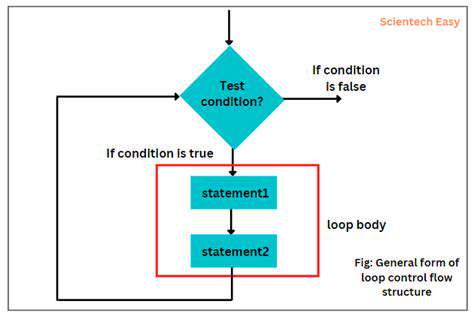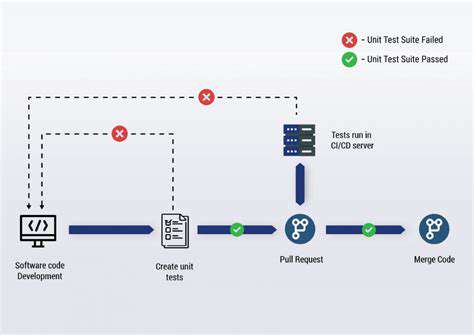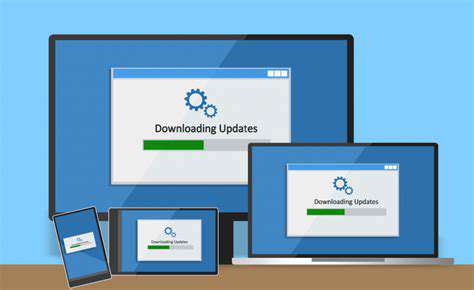Cybersecurity for Beginners: Staying Safe Online
Protecting Your Personal Information Online
Understanding the Risks
Protecting your personal information online requires understanding the various threats you face. Cybercriminals employ sophisticated tactics to steal sensitive data, from phishing scams that trick you into revealing passwords to malware that silently infiltrates your devices. Being aware of these methods is the first step in safeguarding your data and preventing costly or embarrassing consequences.
Knowing the types of attacks, like identity theft and data breaches, is crucial. Understanding how these threats work allows you to anticipate potential vulnerabilities and take proactive measures to mitigate them.
Strong Passwords and Authentication
A strong password is your first line of defense against unauthorized access. Use a combination of uppercase and lowercase letters, numbers, and symbols. Avoid using easily guessable information like your birthday or pet's name. Consider using a password manager to generate and store complex passwords securely.
Multi-Factor Authentication (MFA)
Enabling MFA adds an extra layer of security to your accounts. This involves requiring more than just a password, such as a code sent to your phone or a security key. MFA significantly reduces the risk of unauthorized access, even if a password is compromised.
Safe Browsing Practices
Be cautious about clicking on links or downloading attachments from unknown sources. Verify the legitimacy of websites before entering personal information. Avoid suspicious websites or emails that seem too good to be true. Look for the padlock icon in the address bar to ensure a secure connection.
Protecting Your Devices
Keep your operating system and software updated with the latest security patches. These updates often include crucial fixes for vulnerabilities that hackers could exploit. Regularly scanning your devices for malware and viruses is essential for proactive protection.
Using antivirus and anti-malware software is vital in securing your devices and preventing malicious software from gaining access to your personal data.
Recognizing and Reporting Phishing Attempts
Phishing scams are designed to trick you into revealing sensitive information. Be wary of emails, texts, or calls requesting your login credentials, bank details, or other personal data. Verify the sender's authenticity before responding to any suspicious communication. Report suspected phishing attempts to the appropriate authorities.
Staying Informed and Educated
Cybersecurity threats are constantly evolving, so staying informed about the latest techniques is crucial. Follow reputable sources for cybersecurity news and updates. Take online courses or workshops to enhance your knowledge and skills in protecting your personal information. Continuous learning is essential for adapting to emerging threats and maintaining a strong defense against cybercrime.

Safeguarding Your Devices and Networks
Understanding Common Threats
Cyber threats are constantly evolving, and it's crucial for beginners to understand the various ways their devices and networks can be targeted. Phishing scams, malware infections, and denial-of-service attacks are just a few examples of the dangers lurking online. Learning to recognize these threats is the first step toward protecting yourself. This involves being cautious about suspicious emails, links, and downloads, and understanding how to spot the telltale signs of a malicious website or file. Vigilance is key in this digital age.
Hackers often exploit vulnerabilities in software and operating systems. Staying up-to-date with security patches and updates is essential to minimize these risks. Knowing which software needs updating and how to do so safely can greatly enhance your digital security posture. This includes understanding the difference between legitimate updates and malicious attempts to compromise your system.
Protecting Your Passwords
Strong, unique passwords are the first line of defense against unauthorized access. Creating robust passwords that are difficult to guess or crack is vital. Avoid using easily guessable information like birthdays, names, or pet names. Instead, use a combination of uppercase and lowercase letters, numbers, and symbols. Consider using a password manager to securely store and manage your various passwords, ensuring that each account has its own unique, strong password.
Never share your passwords with anyone, and be wary of websites or applications that ask for your password. Be mindful of phishing attempts, which often try to trick you into revealing your login credentials. Protecting your passwords is paramount to safeguarding your online accounts and personal information.
Using Strong Authentication Methods
Beyond passwords, consider enabling two-factor authentication (2FA) whenever possible. This adds an extra layer of security by requiring a second verification step, often a code sent to your phone, after you log in with your password. 2FA significantly reduces the risk of unauthorized access even if a hacker manages to obtain your password. Implementing 2FA across all important accounts is a crucial step in reinforcing your security.
Review your account security settings periodically. Ensure that the settings are configured to your needs and maintain a high level of security. Understanding the various authentication options available and choosing the right ones for your specific needs will enhance your overall security posture. Regularly reviewing these settings helps prevent vulnerabilities and unauthorized access.
Securing Your Network
A secure home network is essential to protecting your devices from unauthorized access. Use strong Wi-Fi passwords and consider using a Virtual Private Network (VPN) to encrypt your internet traffic when connecting to public Wi-Fi networks. This added layer of protection protects your data from potential eavesdropping and security breaches when using public networks.
Regularly update your router's firmware to patch security vulnerabilities. This is a simple yet effective way to bolster the security of your network. Understanding the importance of router updates and their role in maintaining a secure network environment is vital for protecting your devices and sensitive data.
Keeping Software Up-to-Date
Regularly updating your operating system, applications, and other software is critical. These updates often include security patches that address vulnerabilities that hackers could exploit. Failing to update your software leaves your devices susceptible to various threats, making it important to prioritize these updates to maintain a strong security posture.
Understanding the frequency of updates and how to install them safely is key. This proactive approach significantly reduces your risk of falling victim to malware or other malicious software. Stay informed about the latest security updates and install them promptly for optimal protection.
Recognizing and Reporting Suspicious Activity
Being aware of suspicious activity is essential. If you encounter unusual behavior from your devices or accounts, such as unexpected pop-ups or unusual email activity, investigate immediately. Take steps to identify and address any potential security breaches. This includes immediately changing passwords and reporting suspicious activity to the relevant authorities or platforms.
Learning to identify and report suspicious activity is a crucial aspect of proactive cybersecurity. Being vigilant and taking swift action can prevent serious harm and protect your digital assets. Understand the importance of promptly reporting any unusual activity to the appropriate authorities or platforms.
Practicing Safe Online Habits

Understanding the Risks
Online activity, while offering numerous benefits, presents inherent risks. Cybersecurity threats, such as phishing scams and malware attacks, are constantly evolving, making vigilance paramount. Protecting personal information, including financial details and passwords, is crucial to safeguarding against potential harm. Users need to be aware of the potential for data breaches and the importance of strong, unique passwords for each online account.
Social engineering tactics, often disguised as legitimate communications, can manipulate users into revealing sensitive information. Recognizing these tactics and maintaining skepticism towards unsolicited requests or suspicious links is essential for online safety. Staying informed about current threats and adopting a proactive approach to online security is key to mitigating risks.
Protecting Your Personal Information
Protecting your personal information is paramount in the digital age. Be cautious about sharing sensitive details online, such as your full name, address, phone number, and financial information, unless you are certain the platform is secure and trustworthy. Review the privacy policies of websites and apps before providing any personal data.
Use strong, unique passwords for each online account. Avoid using easily guessable passwords and consider using a password manager to securely store and manage your credentials. Regularly updating your passwords adds another layer of protection against unauthorized access.
Recognizing and Avoiding Phishing Attempts
Phishing attempts are common online threats. Be wary of emails, messages, or websites that request sensitive information, such as login credentials or financial details. Verify the sender's identity and the legitimacy of the request before responding to such communications. Look for signs of suspicious emails, such as poor grammar, misspellings, and generic greetings.
Never click on links in suspicious emails or messages without verifying the source. If you are unsure about the legitimacy of a request, contact the organization directly through official channels to confirm. Taking a proactive approach to verifying the legitimacy of communications is a key part of avoiding phishing attacks.
Maintaining Strong Passwords and Accounts
Strong passwords are crucial for online security. Create complex passwords that combine uppercase and lowercase letters, numbers, and symbols. Avoid using easily guessable information, such as birthdays, names, or common phrases. Using a password manager can significantly enhance password security by generating and storing complex passwords for all your accounts.
Regularly update your passwords to improve security. Monitor your accounts for any unusual activity and report any suspicious behavior promptly to the relevant authorities. Being proactive in maintaining secure accounts is vital in preventing unauthorized access.
Utilizing Secure Browsing Practices
Employing secure browsing habits is crucial for online safety. Use a reliable antivirus and anti-malware software to protect your devices from malicious threats. Keep your software updated to patch security vulnerabilities and ensure maximum protection. Be cautious about downloading files or clicking on links from unknown sources.
Use a secure network, such as a Virtual Private Network (VPN), when accessing public Wi-Fi networks. This helps encrypt your internet traffic and protects your data from unauthorized access. Prioritizing secure browsing practices safeguards your personal information and devices from online risks.
Staying Informed and Educated
Staying informed about emerging online threats and security practices is essential. Follow reputable security resources and websites to stay updated on the latest threats and best practices. Educate yourself about common scams and phishing techniques to better identify and avoid them. Regularly reviewing and updating your knowledge about online safety is critical for maintaining a secure online presence.
Engage in online safety discussions with friends and family to spread awareness. Sharing knowledge and best practices with others can contribute to a safer online community. Keeping abreast of new developments in online security keeps you better equipped to recognize and mitigate emerging threats.
Read more about Cybersecurity for Beginners: Staying Safe Online
Hot Recommendations
- Review: The New [Specific Brand] Smart Lock Is It Secure?
- Best Budget Studio Monitors for Music Production
- Top Flight Simulation Peripherals (Joysticks, Throttles, etc.)
- Top Portable Scanners for Document Management On the Go
- Reviewing the Latest Smart Air Purifiers for Your Home
- Best Portable Photo Printers for Travelers and Memory Keepers
- The Future of Personal Transportation Beyond Cars (Hyperloop, eVTOL)
- Top Network Monitoring Tools [Free & Paid Options]
- Understanding the Tech Behind mRNA Vaccines [A Look Inside]
- Guide to Choosing the Right Gaming Chair for Ergonomics


![How to Build Your First Website with HTML & CSS [Tutorial]](/static/images/25/2025-05/BeyondtheBasics3AAdvancedTechniques.jpg)








![Best Note Taking Apps for Students & Professionals [2025]](/static/images/25/2025-08/SecurityandPrivacyConsiderations3AProtectingYourData.jpg)